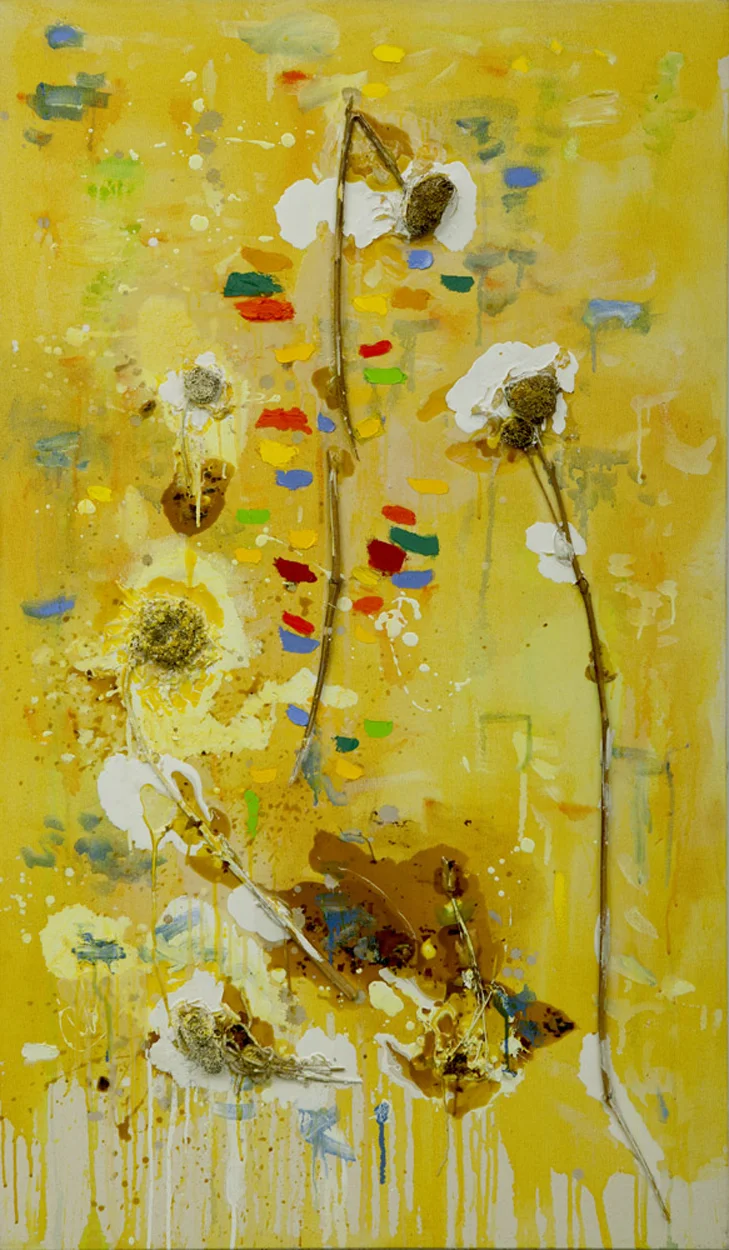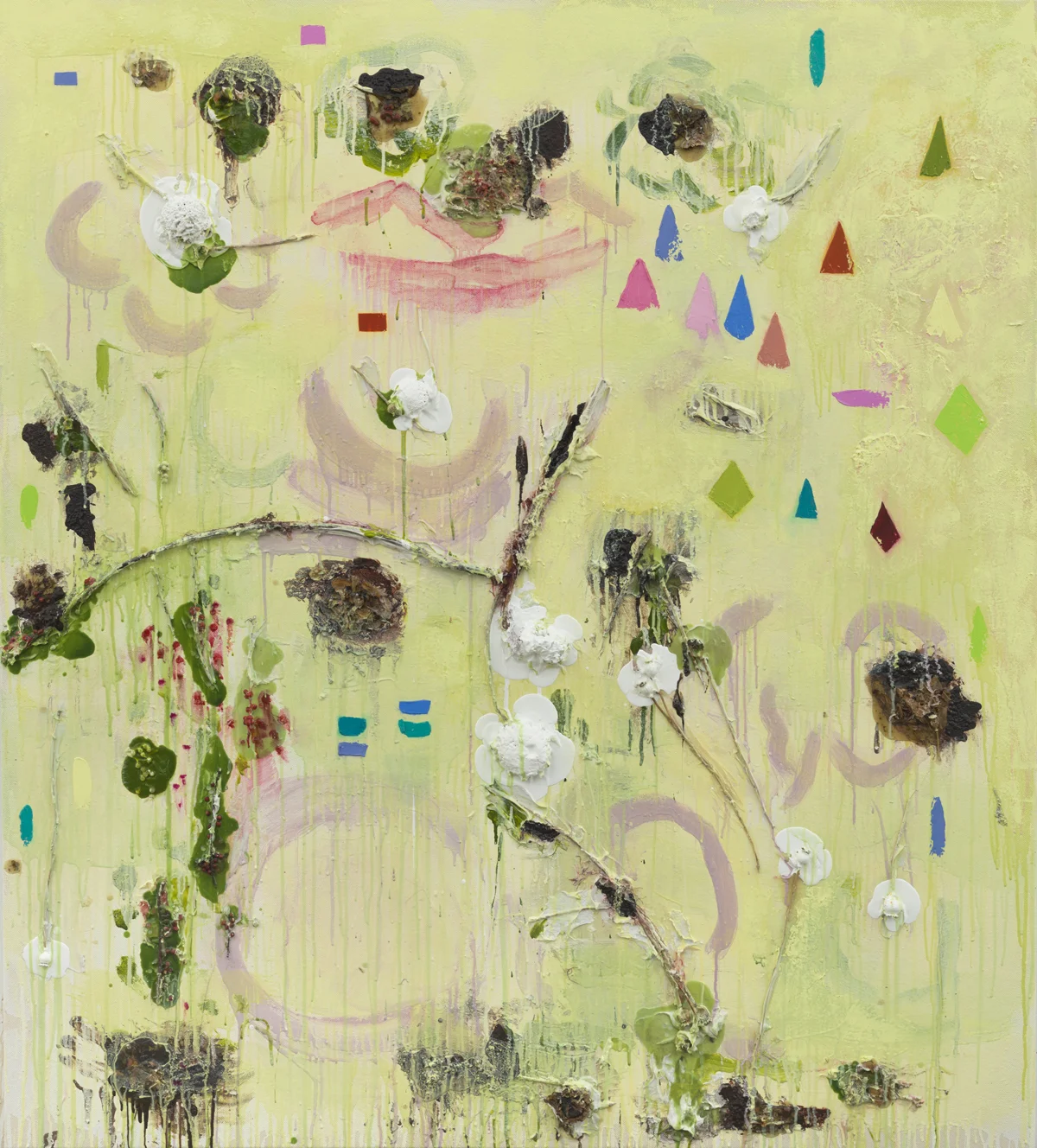
“Prelude/Yellow Field” (2015). Oil, acrylic, dried flowers on canvas. 62 X 36 inches. Courtesy Parrasch Heijnen Gallery, Los Angeles.

“Womansong” (2016). Oil, acrylic, glass beads, dried flowers, mud on canvas. 60 X 54 inches. Courtesy Parrasch Heijnen Gallery, Los Angeles.
[](#)[](#)
Q&A: Joan Snyder
We speak to the established Expressionist painter on the eve of her Los Angeles exhibition
"At the time my idea was studying the anatomy of a stroke, isolating them and using them almost like creating a symphony or a piece of music. My whole idea was to have more, not less in a painting.” So says Joan Snyder, the septuagenarian painter from New York whose show Womansong is currently on view at Parrasch Heijnen.
Snyder burst into the art scene in New York in the ‘60s with a series of pieces called ‘stroke paintings’ which were brush strokes of varying sizes and colors arranged on a grid. Although the art world at the time was dominated by minimalists like Rothko, Snyder considered herself more of an expressionist, reexamining the brush stroke and telling a narrative with the paint.
Womansong will include a previously unseen piece from that era, as well as a new series, which the artist says was created in a burst of creativity over the course of the last fall and winter.
I spoke to Snyder on the phone on the eve of the opening of Womansong.
**What is your definition of expressionism?**
I think it’s someone who expresses a certain amount of emotion in a painting, letting it all hang out in some ways. The opposite would be cool, or impersonal or minimal maybe.
**Going back to minimalism, do you feel that you took something from that, or was your work, for lack of a better term, a reaction to it?**
Well I think I did take something from it, Brice Marden was well known at the time and I liked his work. There’s always something to take from other work, it’s not that I didn’t think people like Rothko were not great artists, but to me, it wasn’t enough, I was looking for more than that. It was also the beginning of the women’s art world in the ‘70s; women were doing something different, we had stories to tell. Our forbearers were not minimalists, or abstract expressionists, there was a language that we were using that was very new in the late ‘60s/early ‘70s.
**In the mid-’70s your work changed quite a bit, you started layering more, and creating these sort of sculptures almost.**
The work did change in the mid-’70s, pretty radically actually, from the stroke paintings. People used to refer to them as ‘lyrical abstraction’ and I always hated that term. One painting that made it change very radically and that was a painting called “The Storm” which the Guggenheim owns now. What happened to me is that I was a young artist and I became very well known very quickly, and it was very difficult because I was suddenly collecting people in my life like butterflies, and also I had a long list of collectors who wanted these stroke paintings, there was a waiting list, and this was in 1973/’74.
I then moved to a farm in Pennsylvania with my now former husband Larry Fink. What it was, is that I made a stroke painting, and every time I made something beautiful with the paint, I covered it up with mud color, browns and reddish browns and blacks, and it was a kind of grid of these dark colors, with a little of the stroke painting showing through. What that was about is that I felt so over-exposed in the art world and that painting was covering it all up. Then I became a feminist.
**How has your relationship to painting changed over the course of your career? Is it easier or harder to pick up the brush now?**
You know, it’s not harder. Miraculously, with the set of paintings that is going to be shown at Parrasch Heijnen, to me it’s always a shock \[to see them\] it’s like, ‘did I really do that?’
The last show I did, in May at Franklin Parrasch in New York, was three years of work that was really about a certain kind of mourning, and suffering and agony. It always ends up being beautiful, but it really ends up being heavy duty stuff that was going on in my life an in my work. Then came the summer where I didn’t work that much, and then the fall and the winter, where suddenly I was making the paintings that you are going to see in this show, and they were so light, and so not-heavy. It was almost like going back to the stroke paintings idea, but bringing with it all the landscape ideas.
In answer to your question, no one was more surprised than me by what came out of that winter. I feel like I still have a lot of ideas.
Womansong is on view at [Parrasch Heijnen](http://www.parrasch-heijnen.com/current/) until June 10th.
1326 s. Boyle Avenue, Los Angeles ca 90023
Gallery Hours are Tuesday - Saturday, 11am - 6pm
